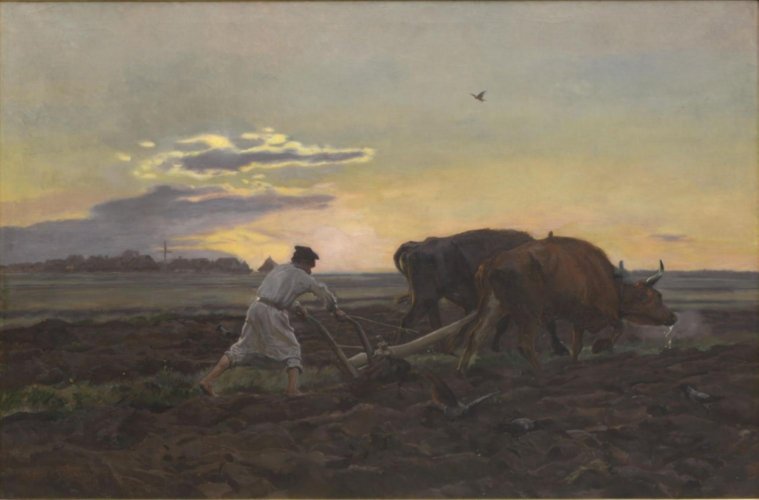Description:
Józef Chełmoński (1848-1914) studied at the Warsaw Drawing Class, then in Wojciech Gerson’s studio. He studied at the Munich Academy, befriending Stanisław Witkiewicz. In 1874-1875 he worked in Warsaw in a studio called the “forge” of Polish Realist painting. His twelve-year stay in Paris was full of works showing peasants at work and animals that gave the artist popularity. After returning to Poland in 1887, he regularly exhibited his works both in the country and abroad, receiving many awards for them. Family problems were the reason for Chełmoński’s move in 1889 to Kuklówka, where he worked until his death. In his work, he dealt with genre scenes and landscapes. He was known as a painter of animals, particularly horses. He worked in the realism style.
Description of the painting:
“Orka” is one of the rural themed paintings that Chełmoński painted while living in Kuklówka. The work was painted outdoors. However, this was not a painting that was supposed to capture the fleeting moment of work in the field, but only to create such an illusion. It is a thought-out composition depicting the essence of the Polish countryside. The artist “chose two thin oxen, ordered a model, dressed him in a long shirt, tied him with a leather belt and went to the field with easels and canvas”. Descriptions of the preparations can be found in the memories of Pia Górska.
The painting depicts a farmer plowing a field in the light of the rising sun. In the foreground, on the ground, birds can be seen feeding on worms that were uncovered during the overturning of the plow. The farmer is bent over, you can see how much strength he puts into pressing the plowshare into the ground. He is dressed in a white smock, his feet are bare. The oxen pulling the plow strain under the weight of the iron embedded in the ground. From the bent head drops saliva, steam is visible from the nostrils, showing how much effort it is. Behind the figures stretches an immeasurable field, over which the sky rises in shades of blue and green. The center of the work is illuminated by the rising sun surrounded by a pink halo. On the second plane, on the left side of the picture plane, in the distance, a village is outlined, in front of which a cross standing in the field is visible.
The work is kept in a dark palette of browns, which gives it a specific, raw mood. The composition is based on the diagonal running from the lower left corner. The direction of the farmer’s journey, to the right, upper corner, makes it a rising diagonal. This gives a symbolic meaning to his figure. Amidst the sleepy, looming in the morning light surroundings, an exceptionally dynamic scene is depicted, which the viewer can almost feel and hear. The song of the waking up in the early morning cuckoo, the cawing of crows, the panting of oxen, or the sound of a plow pulled with enormous effort. The painting shows the dependence of the village on nature, its subordination to it by the peasant, but at the same time its connection with it. The peasant leads the plow barefoot – thus obtaining direct contact with the soil he cultivates. The cross outlined in the distance introduces a symbolic meaning to the work – the cult of the earth having its source in the Bible – “make the land subject to yourself”. This synthetic approach ennobles work in the field, it is almost an apotheosis of the Polish peasant.


